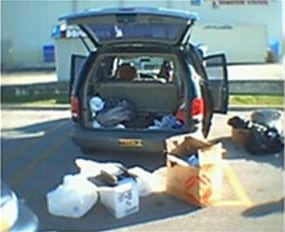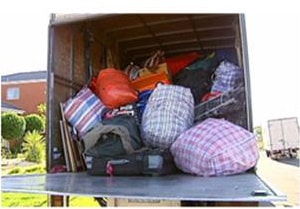“One man’s trash is another man’s treasure” is a popular idiom and an interesting subject. And as it pertains to the thrift store business model—which is a multi-billion dollar industry—it can also be a loss prevention nightmare.
Thrift shops like Goodwill rely on donated goods from the public in order to operate. Donors go out of their way—cleaning out closets, boxing items, and transporting their goods in the spirit of supporting a charity. In exchange for their good deed, donors receive a tax receipt to substantiate their donation, and perhaps more importantly the satisfaction that comes with being able to positively impact their community.
Unfortunately, the intended good deed may only result when the charitable donations are made during business hours. There are times when donors will drop off their donations after business hours with hope that the charity will collect the donation the next day. Regrettably, it doesn’t always work out that way. In fact, donating items after business hours often provides an enticing opportunity for thieves to steal the donations. There are many cases where a Goodwill donor will drop off a donation, and as soon as they leave a vehicle appears. Individuals then emerge and load the donations into their vehicles, stealing the intended contributions. To add insult to injury, Goodwill and other thrift stores are often left finding empty boxes, bags, and unwanted donated items littered all over the sidewalk and parking lot areas.
In one particular investigation, the involved individuals:
- Stole donations,
- Sold the stolen donated items on-line,
- Returned what they didn’t sell,
- Stole more donated items, and
- Repeated the process on multiple occasions from the same location.
A Community Problem
 This has become a huge problem for the thrift industry in general and especially for Goodwill locations across America. But the heart of the problem runs much deeper. The reality is that the resulting losses cost the community much more than a bag of clothes or box of donated items. What is often overlooked is that such thefts decrease the job training opportunities and job placement programs that are provided by Goodwill for free to disadvantaged individuals such as low income families and those who are homeless. Ironically, thefts are often perpetrated by the same population that Goodwill serves. In other words, the very same individuals who could benefit the most from Goodwill’s free job training and placement programs are in some cases those stealing from Goodwill.
This has become a huge problem for the thrift industry in general and especially for Goodwill locations across America. But the heart of the problem runs much deeper. The reality is that the resulting losses cost the community much more than a bag of clothes or box of donated items. What is often overlooked is that such thefts decrease the job training opportunities and job placement programs that are provided by Goodwill for free to disadvantaged individuals such as low income families and those who are homeless. Ironically, thefts are often perpetrated by the same population that Goodwill serves. In other words, the very same individuals who could benefit the most from Goodwill’s free job training and placement programs are in some cases those stealing from Goodwill.
Where do these items go? Research shows that the stolen items will end up at yard and/or garage sales, out of the country, or even online social media sites that sell to unknowing buyers. The problem is further complicated by organized retail crime (ORC) within the thrift industry. ORC groups are often drawn to thrift business due to the lack of traceable inventory.
Implementing a Loss Prevention Program
In an effort to protect and maintain the Goodwill Industry of South Texas stewardship of public donations, a loss prevention program was implemented in 2011. As part of a long-term strategic plan, the loss prevention department has worked in close collaboration with community partners, the Corpus Christi Police Department, and the District Attorney’s Office to identify, arrest, and prosecute those involved in theft incidents. Stakeouts were conducted, surveillance efforts increased, anti-theft education was provided to staff members, and high-tech security equipment was installed with the goal of decreasing the opportunity for dishonest people to take advantage of Goodwill’s operation. Through this innovative collaboration, numerous arrests have been made for misdemeanor and felony theft or criminal trespassing at Goodwill since the program was launched.

One of the characteristics that has separated this program from many other charitable organizations is Goodwill’s willingness to prosecute, sending a strong message to potential thieves. Further, the State of Texas has taken additional steps to protect non-profit organizations from criminal activity by escalating the charges to the next highest criminal level. For example, stealing from Goodwill could easily become a felony offense. In just a few years, Goodwill along with the caring citizens of South Texas have greatly reduced these incidents, sending the message that it’s not okay to steal from a charity. That action is changing the community.
Goodwill Industries of South Texas continues to make loss prevention a crucial element in their business plan and will further serve local communities by fulfilling this mission.
“The mission of Goodwill Industries of South Texas is to create life-changing opportunities for the people with disabilities or barriers to employment.”
About the Author

Carlos Garcia is the director of loss prevention for Goodwill Industries of South Texas, Inc. After a career in law enforcement with the New Mexico State Police and the Quad State Narcotics Task Force, he opened a private investigative business before venturing into loss prevention. Garcia served as an area supervisor for Stein Mart and DLPM for Walgreens prior to his current position.
This article was originally published in November 2015 and updated in August 2021


